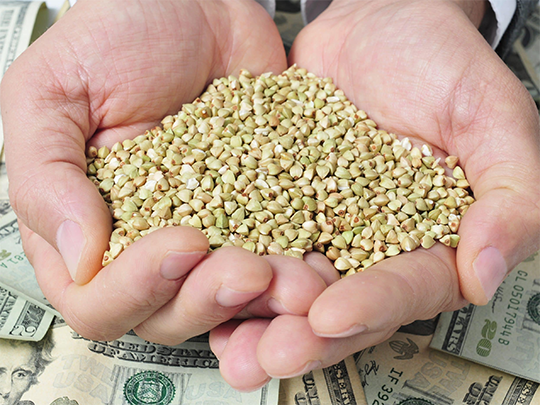Performizer – The strategy for reducing feed costs
You're angry about high feed costs again? That doesn't have to be! Find out in this article how you can use phytogenics to reduce your feed costs.

In times of high commodity prices, investments in feed additives seem to be almost a “luxury good”, as they initially seem to raise feed costs. This assumption is not right as improved nutrient use and animal performance will save feed costs per unit of animal product as long as the genetic capacity of the animal is not reached. The aim of combining nutrient-saving and phytogenic feed additives is to merge their benefits with a modern feeding program that meets modern animal performance while limiting the impact of high feed prices.
The role of phytogenics in reducing feed costs

In addition to management tools to improve animals’ performance, the focus of profitable livestock is on reducing feed costs per unit of the final product. Phytogenics can play an important role in the most cost-effective formulation of a feed.
All Delacon phytogenic feed additives have the same goal: maximum feed efficiency in animal production. Therefore, improved nutrient digestibility is the key to increasing animal performance and a valuable strategy for reducing feed costs. Several bioactive substances in our phytogenic feed additives are highly efficient in stimulating digestive enzymes and facilitating nutrient uptake in the gastrointestinal tract. The use of our products improves feed conversion, which means that the animal can use a higher proportion of the feed provided due to the supplementary phytogenic feed additives.
What possibilities are there to save feed costs through improved nutrient digestibility?
There are two possibilities here: the direct saving of feed costs by means of our Performizer® solution, or by supplementing the phytogenic additive “on top” and thus indirect savings of feed costs.

Performizer® - direct feed cost savings
The above-mentioned increase in nutrient digestibility is converted into nutrient matrix values which are applied to optimize the overall mixed ration. This results in lower cost per ton while maintaining performance.
The nutritional matrix values are based on several digestibility studies and different age groups of each species. Recommended and detailed matrix values for a reduction of nutritional energy, proteins, amino acids and minerals are provided by the Delacon team on request. Let’s now look at the second tool: Performance optimization – another strategy for reducing feed costs.

Performance optimization - Indirect saving of feed costs
Alternatively, if Delacon’ s phytogenic feed additives are applied on-top to a certain feed ration, performance of livestock will be increased. Generally, the positive influence of our phytogenic solutions on nutrient uptake is an improvement of feed conversion ratio. More specifically this results, among others, in increased growth rates, increased egg production and egg weight in laying hens, increased litter sizes and weaning weights in piglet production or in a higher milk yield in dairy cows. Consequently, due to the on-top supplementation of Delacon products feeding costs do decrease in relation to the production of 1 kg of meat, eggs or milk.
Would you like to have an example of the Performizer® solution?
In numerous studies and field trials, the use of Biostrong® 510 has shown that birds’ performance is improved through increased nutrient utilization and maximized feed conversion. Let us have a closer look on this strategy for reducing feed costs: In order to confirm the effectiveness of the Performizer® solution, performance tests were carried out with laying hens:
- 13-week performance test with 864 Lohmann LSL white laying hens
- Production performance was measured over a 13-week trial period, following a two-week pre-experimental period
- The hens were kept in large cages with raised wire floors and fed a corn/soy control diet with and without 150 ppm Biostrong® 510
- The control diet was reformulated based on the full nutrient matrix of the Performizer®, which was also fed with and without 150 ppm Biostrong® 510
The results speak for themselves:
- Biostrong® 510 improved feed conversion by 1.3%, regardless of the control diet
- The supplementation of Biostrong® 510 to both control diets increased egg mass and laying performance (Fig.1)
- Hens fed the ration with the lower nutrient density had a numerically (1.5%) higher feed intake compared to the control diet
- The lower nutrient density of the ration calculated on the basis of the Performizer® nutrient matrix had no influence on the egg mass due to the higher feed intake
This study clearly supports the use of Biostrong® Performizer due to an increase in performance despite a lower nutrient density of the basic feed. When Biostrong® 510 is used, the Performizer® delivers additional value for e.g. crude protein (amino acids) to the feed formula through increased protease activity in the intestinal tract. This means that the use of Biostrong® 510 leads to a saving of approx. 11 kg soybean meal per ton of feed. Since the need for minerals and energy also decreases, more favorable formulations are possible. These reductions play a key role in reducing feed costs while at the same time ensuring a high laying performance

Anne Oberdorf
Anne has always been fascinated by the unknown, the diversity and beauty of nature. Her love for nature brought her to Delacon in 2018 after studying agricultural sciences, where she worked as Technical Communications Manager and later as Product Manager Aquaculture. Since February 2021, she has been taking a new, natural career path outside of Delacon.










